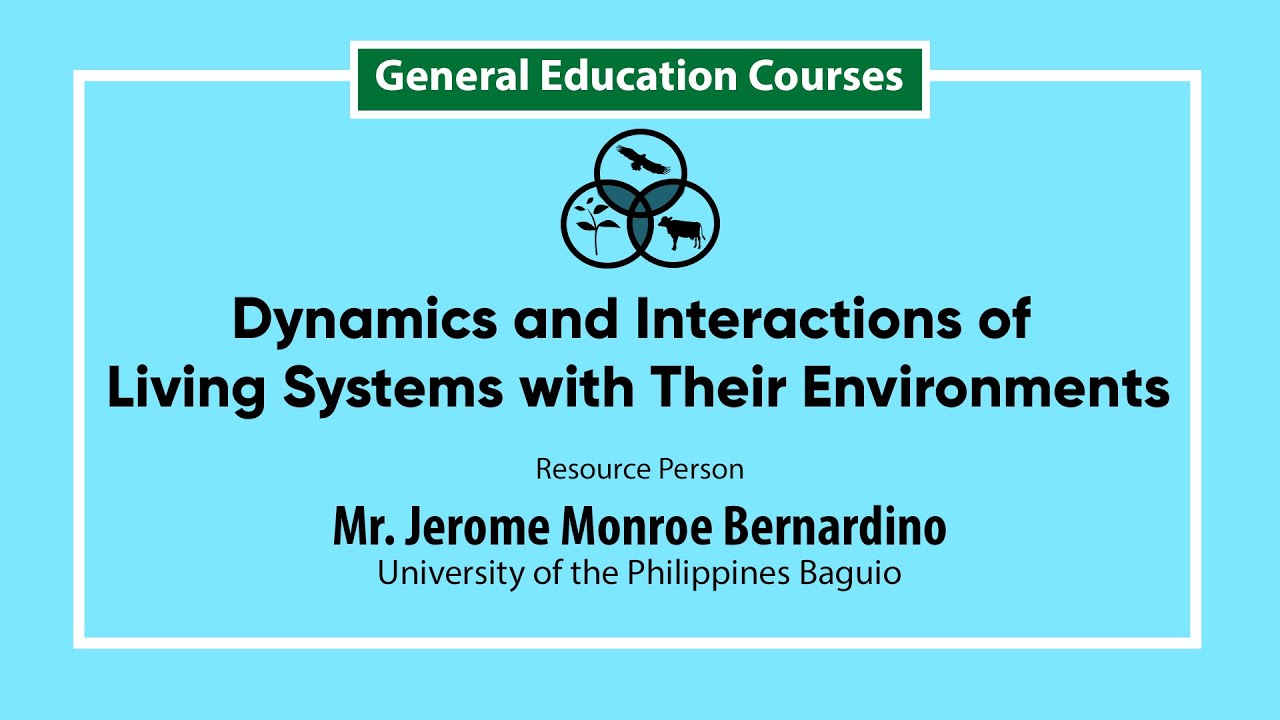Contemporary Issues on Living Systems
Mr. Noel Joseph Galido
The Philippine Archipelago is considered to be one of the most biologically diverse countries in the world, wherein, despite our country’s relatively small aggregate of land areas, the Philippines supports numerous and diverse habitats with a multitude of highly diverse and unique species. Now, among the different regions in the Philippines, the terrestrial environment of the Cordilleras [offers] a variety of habitats which could support, now, many diverse groups of organisms. And so, the question here is why? So, that is basically because of the different forests found [in] the Cordillera region—more specifically, the dipterocarp forests, also, we have your pine forests and we have your mossy forest. Now, regardless of the differences among these forests, one of the most natural features that remains similar would be the complexity and variety of life, known as biological diversity or biotech diversity or biodiversity.
Now, from the name itself, biodiversity literally means the variety and extent of living organisms—their differences among and within living things, whether this living things are well known or are yet to be discovered or whether they range from minute microscopic organisms or to gigantic macroscopic organisms. Now, this is not the only definition of biodiversity, since biodiversity is often described using, now, the different levels of biological organizations. Therefore, we have, now, your genes, your species, and your ecosystem. Now, of course, some of you may think that biodiversity primarily refers only to species, when in fact species or variety of species can also affect, now, the variety as well as the variability of genes together with the diversity of the ecological systems within a landscape. Now, some of you may think that all of these three levels of biological organizations are independent with one another, when, in fact, all of these three are not working in isolation, given the fact that they depend on each other. Which is why, if you are going to take a look at this illustration, the loss of one biodiversity level is already a loss of the whole biodiversity. So, biodiversity in general means there is dependency of all of the different levels of ecological organizations because basically biological diversity requires the attention of all of the three levels. Say, for example, now, genetic diversity, species diversity, and ecosystem diversity. Now, of course, the importance of focusing on all of the three levels of biological organization would be the services that they provide. They provide to sustain, now, the species that will in turn sustain, now, and maintain their respective populations. Say, for example, now, the human population which experiences various ecosystem services, say, for example, your natural resources and area for settlement. Now, since there has been relatively an uncontrolled expansion of the human population, there has been an escalating demand on such ecosystem services. Which is why this uncontrolled acquisition of natural resources as well as greediness in terms of acquiring, now, area for settlement causes—or which therefore exceeded our limits—in turn, now, causing loss of biodiversity.
And so, this, now, raises a question on what is now the state of biodiversity in the Cordillera given this general idea. Now, most of the present landscapes in the Cordillera region is significantly human influenced, characterized more specifically by the patchiness of forests due to excessive human activities. Say, for example, now, mining, illegal logging, and land conversion into urbanized or rural areas or even into agricultural areas, which, in turn, changes, now, the landscape of the Cordillera region. Now, in changing the environment of the Cordillera region also reduced, now, that once rich biodiversity at or in the Cordillera region.
And so therefore, how did this specific human activities greatly damages now biodiversity, further causing loss of biodiversity? Now, let us take for example that there has been a damage at an ecosystem level. So, damage to biodiversity does not really occur only at an ecosystem level in our example, since damage in the habitat results also to the decline of the species, further leading to the loss of gene pools as well as gene variability. And so, therefore, overall, the main factor directly driving biodiversity loss in the Cordillera region would, now, be habitat alteration and habitat destruction of the three main forest types in the Cordillera—and again, that would be the dipterocarp forest, the pine forest, and the mossy forest—resulting to habitat loss. Now, in this process existing organisms have been or can be displaced, say, for example, in the process of illegal logging. Now, if you are going to take a look at the figure below, your dipterocarp forest that illustrates to you an illegal logging activity last May 15, 2016 in Bauko, Mountain Province—all for the purpose of timber collection. Now, besides the displacement of existing organisms, this existing organisms can also be destroyed. Say, for example, in the process of kaingin, as you can see on the figure beside your illegal logging activity, illustrating to you an uncoordinated kaingin process in a specific land area in Mt. Pulag last July 1, 2016—all for the purpose of transforming it into an agricultural area. So, as you can see, there is a goal in performing such processes, wherein, in clearing forest areas, they now extract natural resources or that they convert this areas into urbanized or even into agricultural areas. Now, among the different types of forests found in the Cordillera, it is usually the mixed dipterocarp forest and the mossy forest in the Cordillera which are converted into agricultural areas. Which is why, as you can see from the figure below, your dipterocarp forest, we have there your image pertaining to an agricultural area nearby your Chico River passing the Cordillera region which was once a mixed dipterocarp forest. Also, beside it, we have your agricultural area in a piece of land in Mt. Pulag which was once a mossy forest.
Now, in these processes, they now result to habitat loss which occurs when area suitable for maintaining a species are eliminated, thus, the original habitat declines and so does the number of individual species decreasing, now, not only species diversity, not only genetic diversity, but also due to diversity loss at an ecosystem level. Now, some of you may ask, how is this even related with loss of biodiversity at a genetic as well as at the species level?—given the fact that the new vegetation, that new habitat cannot really support the original species, all of those original species, since some of those species have needs only produced by the original vegetation. Say, for example, now, your agricultural areas—your agricultural systems—they are new vegetation types that cannot really support all of those original and existing organisms. And so therefore, we should expect that at, or in, agricultural areas they have less diversity, which could support only a few species, which could contribute less to the overall ecosystem functioning. So therefore, unlike by agrobiodiversity, biodiversity is complete in terms of ecosystem services, given the fact that it has greater diversity, thus, greater species that could have greater contributions to ecosystem functioning which in term influences, now, ecosystem services.
Now, the conversion of habitats is not the only example that can cause loss of biodiversity because we also have, now, habitat fragmentation of the original vegetation which exacerbates, now, biodiversity loss. Say for example, from the first figure, we have now your patch of Busol forest surrounded by urban areas. Another example would be a patch of forest in Ifugao, now, surrounded by agricultural areas.
And so, how did we end up having this patches of forest?
Now, of course, in the beginning, we have this sea of forest ecosystems and patches of either urban areas or patches of agricultural areas. Now, due to uncontrolled human expansion, of course, expect that these patches or, technically, your islands of urban areas and islands of agricultural areas will also expand. And as they continuously expand later on, this will result to a sea of urban areas or a sea of agricultural areas having, now, only patches or islands of your forest or your original vegetation. Now, from this remaining undisturbed patches would, now, be the loss of the capability to support all of the existing organisms, since this will support less wildlife, given the fact that the area or these ecosystem patches are relatively too small to even support all of those existing organisms, since all of these organisms have minimum area requirements for their populations to persist within that specific limited area. Now, from this remaining undisturbed patches or ecosystem patches, of course, they will support less wildlife, given the fact that many of these patches would have relatively too small areas to support, now, all of those existing organisms, given the fact that all of these organisms or that these species have minimum area requirements for their populations to persist in that limited area. Which is why, if you are going to take a look at the figure, first, we have that specific area which was not yet produced or which was not yet a result of habitat fragmentation, wherein, as you can see, we have three types of interior species: we have your yellow, we have your red, and your gray interior species. Now, in the process of habitat fragmentation, of course, it resulted to two fragmented habitats, which only supported two out of the three interior species, which could possibly lead us to conclude that the gray interior species have minimum requirements which did not really encompass those of the resulting fragmented habitats. Now, what is more troubling here is that ecosystem patches are functionally smaller than their total area suggests or than what their total area suggests, since edges are technically ecologically different as compared to the interior habitats. Thus, interior species in reality would have lesser area which could only support, now, a small population size. Now of course, this small population size would now be prone to the effects of inbreeding. And so, this now raises a question on why is it that small population sizes often effects now or is often affected now, by inbreeding? Technically, because as you can see from this figure, the area between the two fragmented habitats are basically inhospitable areas—inhospitable areas which can serve as impassable barriers to species, which could cause loss of connectivity between subpopulations. Now, in the loss of connectivity between these subpopulations, of course, this will now allow the small population size to restrict themselves to perform, now, inbreeding.
Now, the next question here is that how is inbreeding, now, troublesome? What is the relationship of inbreeding to the loss of biodiversity?
Now, in the process of inbreeding, of course, this could lower genetic variation, in turn, reducing, now, the fitness of the population. Now, if you’re going to take a look at the graph with the y-axis representing to you inbreeding coefficient of the population and the y-axis representing to you the log of fitness or the capability of that population to survive. Now, as inbreeding continues, of course, expect that the inbreeding coefficient will also increase. Now, upon the increase of inbreeding coefficient, of course as you can see from the graph, this also lowers the capability of the population to survive, therefore, reducing, now, the biodiversity of that specific patch or of that specific habitat fragment.
Now, besides inbreeding, one of the main causes also of habitat fragmentation would be to allow extinction of the population, mainly due to the processes of inbreeding, which now causes alterations or changes in species interaction and ecosystem services. Now, if you are going to take a look at this gray figure which illustrates to you a food web, now, of course, the removal of an important species so plays an important role in this food web could cause the collapse of this food web, further collapsing, now, your eco system—your total ecosystem. Now, of course, all of these processes of habitat fragmentation and habitat loss, all of which contributes, now, to the increasing biodiversity loss. Some of you may even ask “why is it even important to conserve biodiversity?” Now, there are two main reasons. First is that greater biodiversity supports, now, a more complex ecosystem interaction. Now, the importance of having a complex ecosystem interaction is that it minimizes the effects of destructive forces. Now, the second reason why we need to conserve biodiversity would be given the fact that biodiversity is the earth’s life support system, in such a way that we depend on it for the air we breathe, for the food that we eat, as well as the water that we drink. Now, given the importance of biodiversity, therefore, conservation should be all year round and that conservation of biodiversity is a must.
How useful was this resource?
Click on a star to rate it!
Average rating 0 / 5. Vote count: 0
No votes so far! Be the first to rate this post.
We are sorry that this post was not useful for you!
Let us improve this post!
Tell us how we can improve this post?

























